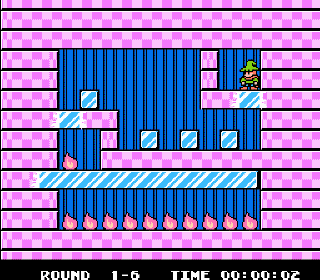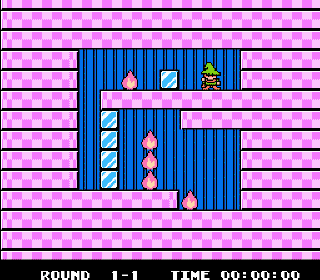 In Fire 'N Ice, we once again
help a wizard named "Dana" to clear a series of rooms filled with enemies using
his magical powers. In this game, Dana can create, destroy, and push blocks of ice. He
uses these blocks of ice to extinguish his fiery enemies. A room has been cleared once all
of the enemies in the room have been defeated. The game is made up of 15 levels of 10
rooms each with the 10th room of each level being a "boss" room. A final boss
room played after all 100 rooms have been cleared marks the end of the first part of the
game, and after an additional five levels have been completed, Dana faces the game's final
boss.
In Fire 'N Ice, we once again
help a wizard named "Dana" to clear a series of rooms filled with enemies using
his magical powers. In this game, Dana can create, destroy, and push blocks of ice. He
uses these blocks of ice to extinguish his fiery enemies. A room has been cleared once all
of the enemies in the room have been defeated. The game is made up of 15 levels of 10
rooms each with the 10th room of each level being a "boss" room. A final boss
room played after all 100 rooms have been cleared marks the end of the first part of the
game, and after an additional five levels have been completed, Dana faces the game's final
boss.As with most puzzle games, the difficulty grows progressively harder as one advances through the game. The difficulty peaks with the boss battle at the end of level 10, drops down again at the beginning of level 11, and ramps back up as one moves towards the end of level 15. Veterans of Solomon's Key may find the game particularly frustrating, as the lack of a jumping ability, absence of fireballs, and ability to create a block of ice only diagonally below Dana makes the gameplay feel a bit more limited. These limitations are quickly overcome as one plays the game.
An excellent feature of the game is the ability to play through the levels in any order, as is the case with Solomon's Club (GB). At the level selection/overworld map screen, the player can cycle through the first 10 levels and select any of the first nine rooms in each level. Once those rooms of any level are completed, the 10th room becomes available for play. Levels 11-15 only become available once the first 10 levels and the boss battle have been completed.
Possibly the best feature of this game is the inclusion of a level editor. One can create levels using any of the items found in the game, which expands the playability of the game greatly. If you have a buddy to play the game with, you can each attempt to stump the other with your challenging creations. Unfortunately, the absence of any kind of battery back-up system makes it impossible to save your levels. Thankfully, the game employs a password system so that you can continue your progress through the game without having to start over.
The graphics of this game can best be described as average. The game begins with a telling of the story, complete with a slideshow-style progression of pictures. The game has a very colorful and detailed overworld map on the level-selection screen. The actual rooms however are very basic. In terms of graphics, and the lack of an interesting array of items and enemies make the game a visual step backward in the series. The developers attempted to spice things up by changing the color scheme of the rooms based on the level in which they appear, but it is not enough to keep the levels from appearing uninspired.
 The game's music is more varied than its
previous iteration on the Nintendo. The game has an actual introduction complete with
music and the overworld map has its own track. Although each room in a particular level
has the same music, the tracks vary from level to level. The sound effects are standard
fare for a puzzle game, and are not interesting enough to add anything to the gaming
experience.
The game's music is more varied than its
previous iteration on the Nintendo. The game has an actual introduction complete with
music and the overworld map has its own track. Although each room in a particular level
has the same music, the tracks vary from level to level. The sound effects are standard
fare for a puzzle game, and are not interesting enough to add anything to the gaming
experience.Gameplay is where this title excels. For a gamer that is into a more action oriented puzzler like Bomberman, Bugs Bunny Crazy Castle, or Crystal Mines II, this game provides a solid gaming experience. Once the learning curve is surmounted, it is easy to fall into the rhythm of the game.
My only caveat concerning this game is that it should not be assumed by a potential buyer that a love of Solomon's Key will translate into a love of Fire 'N Ice. The games may be similar, but the differences are significant enough that one may love one title and not care for the other. If you are a puzzle enthusiast looking for a new game to sink your teeth into, however, then you should definitely give this one a go.